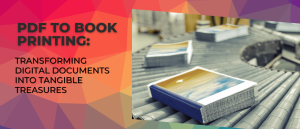Table of Contents
ToggleIn the modern age of technology, the way we consume literature has undergone a profound transformation. The battle between printed books and digital books has sparked impassioned discussions among avid readers, scholars, and tech enthusiasts.
Printed books, with their tactile pages and intoxicating scent, have been cherished companions for centuries, embodying a tangible connection to the written word.
On the other hand, digital books, accessible via e-readers, smartphones, and tablets, offer unparalleled convenience with vast libraries at our fingertips. But beyond the convenience factor, this debate delves into the very essence of reading itself – the sensory experience, the emotional connection, the environmental impact, and the evolving landscape of publishing.
At Custom Books Printing, we embark on a journey through the pros and cons of each medium, weighing the nostalgia and aesthetic appeal of printed books against the portability and efficiency of their digital counterparts.
In a world where the written word is more accessible than ever, we aim to explore the nuances of this timeless debate, shedding light on how these two formats coexist and continue to shape our literary world.
The Age-Old Question: Print or Digital?
In an era dominated by digital technology and the rapid proliferation of e-readers, the debate between printed books and digital books has never been more fervent.
While digital books undoubtedly offer convenience and portability, there is a timeless allure to printed books that continues to captivate readers.
Printed books possess a tactile quality that digital books simply cannot replicate. The feel of crisp pages beneath one’s fingers, the weight of a book in hand, and the rustle of pages turned are sensory experiences that immerse readers in the story.
The smell of a freshly printed book carries with it the promise of a new adventure, a unique olfactory delight that e-books can’t match.
Beyond the sensory pleasures, printed books offer a sense of permanence. They line the shelves of personal libraries, becoming cherished possessions and sources of nostalgia.
There’s a visual appeal to a well-curated bookshelf, showcasing not just literary taste but also a slice of one’s identity. Printed books also hold cultural significance.
They have been instrumental in the preservation of knowledge, the dissemination of ideas, and the storytelling traditions of societies for centuries. Many readers find solace in the history and tradition that printed books embody.
The Tangible Charm of Printed Books
Printed books possess an irreplaceable, tangible charm that has endeared them to readers for centuries. This allure stems from a sensory experience that digital media struggles to replicate.
The very act of holding a book, feeling the texture of its pages, and hearing them rustle as you turn them creates an intimate connection with the text that goes beyond words.
The cover design, the weight of the book in your hands, and the visual layout of the pages all contribute to the book’s character. Whether it’s the rustic charm of a vintage hardcover or the crisp elegance of a new release, printed books tell a story not only through their content but also through their physicality.
Perhaps one of the most beloved aspects of printed books is their distinctive scent. The aroma of paper and ink, especially in older volumes, evokes a sense of nostalgia and anticipation, like opening a treasure chest of knowledge and imagination.
The Environmental Impact of Printed Books
Certainly, let’s examine the environmental impact of printed books with points in favor of printed books:
1. Sustainable Forestry:
Many publishers and paper manufacturers now source paper from sustainably managed forests. This responsible forestry practice ensures that trees are replanted, maintaining a renewable resource.
2. Recyclability:
Paper is highly recyclable. Printed books can be recycled into new paper products, reducing the amount of waste sent to landfills.
3. Longevity:
Printed books have a long lifespan. Well-maintained books can be read and enjoyed for generations, reducing the need for constant reprints and resource consumption.
4. Low Energy Consumption:
The production of printed books, although resource-intensive, generally consumes less energy compared to the manufacturing of electronic devices used for digital reading.
5. Local Printing:
Smaller, independent publishers often print their books locally, reducing the carbon footprint associated with long-distance transportation.
6. No Electronic Waste:
Unlike electronic devices, printed books don’t contribute to the growing problem of electronic waste, which can be challenging to recycle and dispose of responsibly.
7. Bookstores and Community Hubs:
Physical bookstores serve as community gathering places and cultural hubs, fostering a sense of connection that digital platforms may lack.
8. Physical Libraries:
Public libraries provide access to printed books for free, promoting book-sharing and reducing the demand for personal book ownership.
9. No Batteries or Electricity:
Printed books don’t rely on batteries or electricity, making them accessible in areas with limited or no power resources.
10. Collectibles and Artifacts:
Some printed books become valuable collectibles or artifacts, further extending their useful life and preserving cultural heritage.
The Convenience of E-readers and Tablets
E-readers and tablets have revolutionized the way we access and consume written content, offering unparalleled convenience in the digital age.
Here are some key aspects highlighting their convenience:
1. Portability:
E-readers and tablets are lightweight and compact, allowing readers to carry an entire library with them wherever they go. This portability is particularly advantageous for travelers or those with limited storage space.
2. Vast Libraries:
With digital devices, readers can access a vast selection of books, magazines, and articles instantly, eliminating the need to visit physical bookstores or libraries.
3. Adjustable Text:
E-readers and tablets offer adjustable font sizes and styles, making it easier for individuals with visual impairments to read comfortably.
4. Search Functionality:
Digital texts are searchable, enabling readers to find specific information or keywords quickly. This feature is especially useful for academic or research purposes.
5. Annotations and Highlights:
E-readers allow users to make annotations, highlight text, and bookmark pages without damaging the book. These digital notes can be easily referenced and shared.
6. Environmental Impact:
E-books contribute to environmental conservation by reducing the demand for paper, ink, and transportation associated with printed books.
7. Instant Downloads:
Purchasing and downloading e-books is a seamless process, often taking mere seconds. This immediacy appeals to readers who prefer instant gratification.
8. Customization:
E-readers enable users to customize the reading experience, from adjusting text size and background color to choosing from a variety of fonts.
9. Audio and Multimedia:
Many digital books incorporate audio narration and multimedia elements, enhancing the reading experience, particularly for children’s books and educational materials.
10. Accessibility Features:
E-readers and tablets often include accessibility features such as text-to-speech functionality and screen readers, making reading accessible to individuals with disabilities.
Digital Book Annotations and Highlights
One of the distinct advantages of digital books, whether read on e-readers, tablets, or reading apps, is the ability to annotate and highlight text seamlessly. This functionality enables readers to delve into the content at a more profound level.
Annotations serve as digital margin notes, where readers can jot down their thoughts, questions, or insights without altering the original text. Highlights, on the other hand, emphasize key passages or sentences, making it easy to revisit essential points.
These digital annotations and highlights not only enhance the reading experience but also serve as valuable tools for research, academic study, or book club discussions.
Additionally, the convenience of digital annotations lies in their portability and shareability; readers can access their notes across devices and even share them with others, fostering a sense of interconnectedness in the digital reading community.
This digital feature has undoubtedly expanded the horizons of reading, making it an interactive and collaborative endeavor.
The Cost Factor: Printed Books vs. E-books
When it comes to the cost of reading, printed books and e-books each have their own economic advantages. Printed books, despite their charm and tactile appeal, often come at a higher price point. Factors such as production, distribution, and retailer margins contribute to this cost.
On the other hand, e-books generally tend to be more budget-friendly. They eliminate the expenses associated with physical production and transportation, allowing publishers to offer digital titles at a lower cost.
Furthermore, e-book readers have access to a plethora of free or discounted digital books, including classics and self-published works. Libraries also provide an array of e-books for borrowing, reducing the financial burden on readers.
While printed books may hold sentimental value and aesthetic allure, e-books offer an accessible and economical alternative, making reading more affordable for a broader audience. In the end, the decision between the two options relies on individual preferences and budgetary factors.
The Impact of Technology on Reading Habits
The advent of technology, particularly the proliferation of digital devices and the internet, has profoundly transformed reading habits. Here are some key ways in which technology has influenced how we read:
1. E-books and Digital Libraries:
E-books have gained popularity, offering readers the convenience of accessing a vast library of titles on compact devices. Digital libraries have made it easier than ever to borrow and read books without leaving home.
2. Audio and Text-to-Speech:
Audiobooks and text-to-speech technology have made literature accessible to a broader audience, including those with visual or reading impairments. Commuters and multitaskers also benefit from the ability to listen to books.
3. Social Reading:
Online book communities, forums, and social media platforms have facilitated discussions, recommendations, and book sharing, fostering a sense of community among readers.
4. Personalization:
E-readers and apps allow readers to customize their reading experience, adjusting font sizes, backgrounds, and lighting to suit their preferences.
5. Accessibility:
Digital formats have made literature more accessible to people with disabilities through features like screen readers, voice commands, and dyslexia-friendly fonts.
6. Global Reach:
Technology has enabled readers to access literature from around the world, breaking down geographical barriers and exposing readers to diverse cultures and voices.
7. Interactive Content:
Enhanced e-books and educational apps incorporate multimedia elements, interactive quizzes, and hyperlinks, enhancing the learning experience.
8. Book Discovery:
Algorithms and recommendation engines use reading habits and preferences to suggest new books, helping readers discover titles they might not have encountered otherwise.
9. Easier Publishing:
Technology has democratized publishing, allowing authors to self-publish e-books and reach a global audience without traditional gatekeepers.
10. Multitasking:
Technology has enabled multitasking, allowing people to read in various contexts, such as while exercising, commuting, or waiting.
The Role of Bookstores in the Digital Age
In the digital age, bookstores have undergone a transformation, adapting to changing consumer preferences and technological advancements. While the rise of e-books and online retailers has posed challenges, physical bookstores continue to hold a vital role in the literary world.
They serve as more than just commercial spaces; they are cultural hubs, community centers, and sanctuaries for bibliophiles. Bookstores provide a tangible, sensory experience that online platforms cannot replicate, allowing readers to browse shelves, feel the weight of a book in hand, and savor the comforting scent of ink and paper.
Many bookstores also host author events, book clubs, and reading workshops, fostering a sense of community and intellectual exchange. Furthermore, independent bookstores curate unique selections, champion local authors, and offer personalized recommendations, enriching the reading experience.
In this digital era, bookstores continue to evolve, demonstrating their resilience as irreplaceable havens for literary exploration and connection.














